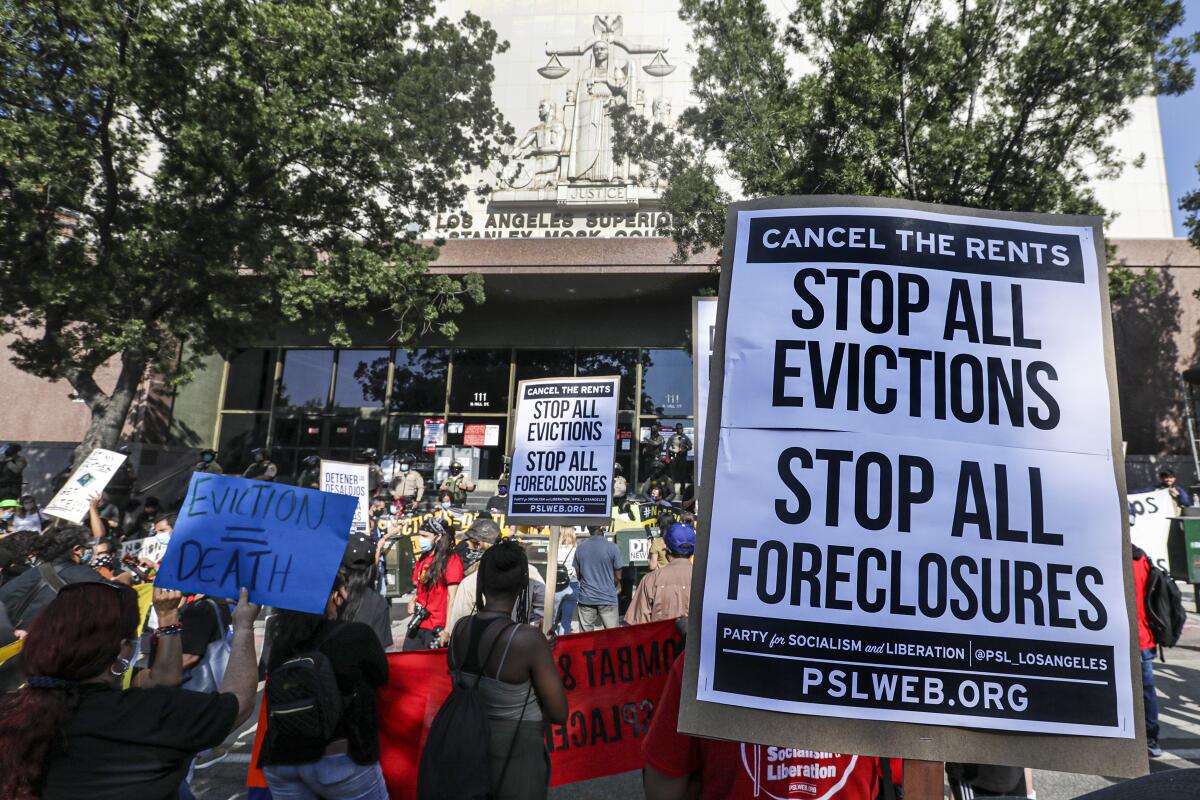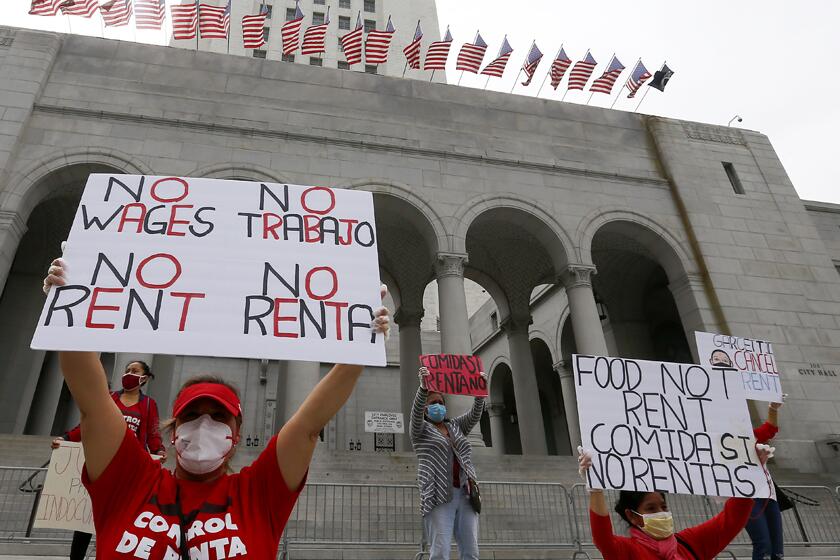Editorial: Why is it taking so long to get rent relief to tenants and landlords?

- Share via
California lawmakers are again scrambling to extend the state’s eviction moratorium for tenants who fell behind on their rent during the pandemic and are still waiting for promised emergency rental assistance to be delivered.
Eviction protections are supposed to expire Friday, but hundreds of thousands of California households that have filed for rent relief have yet to have their applications approved or the money delivered. A little over a year after California began accepting applications, more than 275,000 requests for aid — 56% of those submitted — are still pending.
It would be cruel and counterproductive to let landlords oust tenants for nonpayment of rent now simply because the state is behind in processing relief applications. So legislators are right to fast-track Assembly Bill 2179 to give tenants another three-month reprieve from eviction if they filed the paperwork by March 31 for assistance to cover their rent debt. After April 1, tenants in most jurisdictions could face eviction if they have not paid the current month’s rent (with exceptions for the city of Los Angeles and other jurisdictions that adopted longer eviction moratoriums before August 2020).
The bill is expected to sail through the Legislature, and Gov. Gavin Newsom is expected to sign it before the current protections expire Friday.
Renters and landlords have until March 31, 2022, to apply for aid from California’s rent relief program. After that, no new applications will be accepted.
It’s frustrating that they have to take this step at all. While the state has set a goal of processing applications in 30 days, it has taken, on average, four months for applicants to get approval and funding. Some delay is understandable, considering that this is a new program and the state is trying to avoid the type of fraud and duplication that characterized the rushed deployment of unemployment benefits. California’s is the largest rent relief distribution program in the country, twice as big as New York’s program, which is No. 2.
But it is unacceptable that, a year later, California hasn’t delivered relief to half of the households waiting for help — and that’s not including the tenants who qualify but haven’t applied, perhaps because of language or technological issues. The state must do everything possible to expeditiously review applications and get the money out the door. Tenants need security, and landlords can’t continue to subsidize the housing safety net.
It’s good that lawmakers are moving swiftly, but the eviction moratorium extension proposal is flawed and could leave some tenants behind. Legislative leaders brokered an uncomfortable compromise to address landlords’ and tenants’ requests.
To appease landlords, the bill preempts some local policies passed in San Francisco, Fresno and Los Angeles County that extend eviction protections beyond April 1. In Los Angeles County, the Board of Supervisors voted in January to prohibit eviction of tenants affected by COVID-19 through the end of the year, in recognition of the fact that many renters were still facing financial hardship. For months, the county has been telling tenants they have plenty of time — but AB 2179 would override the county’s ordinance, meaning tenants could unwittingly face eviction if they don’t pay the rent that’s due April 1.
The state already has a housing crisis. Let’s not unintentionally push more people into it.
And there’s another problem on the horizon. The state Housing and Community Development Department warned legislators that the three-month extension still won’t be enough time to process all the relief applications received by March 31. The department asked for an additional month before the last eviction protections expire — a request legislators ignored.
What’s going to happen in mid-June if the state still has unprocessed applications? Will lawmakers scramble yet again to pass an emergency extension to ensure that no one gets evicted because the clock ran out on relief processing? Or will they just throw up their hands and leave those last luckless tenants to fight their evictions in court?
When Congress voted to spend an unprecedented $46.6 billion on federal emergency rental assistance, the goal was to keep tenants housed and landlords whole amid the upheaval created by pandemic shutdowns and the economic fallout. Few expected that more than a year later, so many landlords and tenants would still be in limbo.
More to Read
A cure for the common opinion
Get thought-provoking perspectives with our weekly newsletter.
You may occasionally receive promotional content from the Los Angeles Times.











